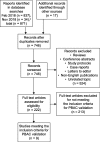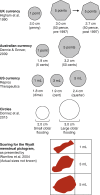Pictorial methods to assess heavy menstrual bleeding in research and clinical practice: a systematic literature review
- PMID: 32041594
- PMCID: PMC7011238
- DOI: 10.1186/s12905-020-0887-y
Pictorial methods to assess heavy menstrual bleeding in research and clinical practice: a systematic literature review
Abstract
Background: Pictorial blood loss assessment charts (PBACs) represent the most widely used method to assess menstrual blood loss (MBL) in clinical trials. The aims of this review were to: (1) determine the diagnostic accuracy of PBACs that have been validated against the reference alkaline hematin technique; (2) categorize the pitfalls of using obsolete and nonvalidated charts; (3) provide guidelines for development of a new PBAC or use of an existing chart to measure MBL in clinical trials; and (4) consider the feasibility of using pictorial charts in primary care.
Methods: A literature review was conducted using Embase and MEDLINE databases. The review identified reports of women with self-perceived or actual heavy menstrual bleeding (HMB), bleeding disorders, abnormal uterine bleeding, leiomyomata (uterine fibroids) or endometriosis, and women undergoing treatment for HMB, as well as those with normal menstrual periods. Data were reviewed from studies that focused on the development and validation of PBACs and from those that used derivative noncertified charts to assess HMB.
Results: Nine studies reported validation of PBAC scoring systems against the alkaline hematin technique. Across these studies, the sensitivity was 58-97%, the specificity was 7.5-95.5%, the positive and negative likelihood ratios were 1.1-13.8 and 0.14-0.56, respectively, and the diagnostic odds ratio was 2.6-52.4. The cut-off score above which the diagnosis of HMB was made ranged from 50 to 185. Several modifications of these PBACs were used in other studies; however, objective confirmation of their validity was not reported. Overall, there was widespread inconsistency of chart design, scoring systems, diagnostic cut-off limits and post-treatment outcome measures.
Conclusions: PBACs are best suited to the controlled and specific environment of clinical studies, where clinical outcome parameters are defined. The current lack of standardization precludes widespread use of the PBAC in primary care.
Review registration number: PROSPERO international prospective register of systematic reviews: CRD42016030083.
Keywords: Abnormal uterine bleeding; Alkaline hematin; Bleeding disorders; Endometriosis; Heavy menstrual bleeding; Menstrual blood loss; Menstrual pictogram; Pictorial blood loss assessment chart; Uterine fibroids.
Conflict of interest statement
J.L.M. has received payment for consulting and medical writing services from Bayer AG for this and other work. S.O’B. has received a grant to his institution from Bayer AG for menstrual pictogram research and from Advantage West Midlands (a company involved in the development of an electronic version of premenstrual syndrome charts, pain charts and an alternative menstrual pictogram) for symptometrics. He has received payment from Asarina Pharma for consultancy work and to act as Chief Investigator for a randomized controlled trial on premenstrual syndrome, and from Bayer for consulting services and expert testimony for the licensing of, and lectures on, OC Yaz. He has also been an unpaid Chair for the International Society for Premenstrual Disorders (ISPMD) and has received payment for intellectual property issues unrelated to the work in this manuscript. C.S. and C.G. are full-time employees of Bayer AG.
Figures






Similar articles
-
A systematic review of methods to measure menstrual blood loss.BMC Womens Health. 2018 Aug 22;18(1):142. doi: 10.1186/s12905-018-0627-8. BMC Womens Health. 2018. PMID: 30134884 Free PMC article.
-
A quick method to customize pictorial blood assessment tools towards better measurement: Method development and validation.Taiwan J Obstet Gynecol. 2024 Jul;63(4):506-512. doi: 10.1016/j.tjog.2022.08.023. Taiwan J Obstet Gynecol. 2024. PMID: 39004477
-
Pictorial blood loss assessment chart in the evaluation of heavy menstrual bleeding: diagnostic accuracy compared to alkaline hematin.Gynecol Obstet Invest. 2011;71(4):281-4. doi: 10.1159/000320336. Epub 2011 Jan 13. Gynecol Obstet Invest. 2011. PMID: 21228538
-
Prevalence and knowledge of heavy menstrual bleeding among gynecology outpatients by scanning a WeChat QR Code.PLoS One. 2020 Apr 2;15(4):e0229123. doi: 10.1371/journal.pone.0229123. eCollection 2020. PLoS One. 2020. PMID: 32240178 Free PMC article.
-
Assessing the impact of hormonal contraceptive use on menstrual health among women of reproductive age - a systematic review.Eur J Contracept Reprod Health Care. 2024 Oct;29(5):193-223. doi: 10.1080/13625187.2024.2373143. Epub 2024 Jul 15. Eur J Contracept Reprod Health Care. 2024. PMID: 39007750
Cited by
-
The Prevalence of Menstrual Cycle Disorders and Menstrual Cycle-Related Symptoms in Female Athletes: A Systematic Literature Review.Sports Med. 2023 Oct;53(10):1963-1984. doi: 10.1007/s40279-023-01871-8. Epub 2023 Jun 30. Sports Med. 2023. PMID: 37389782
-
Abnormal Uterine Bleeding in Perimenopausal Women: The Role of Hysteroscopy and Its Impact on Quality of Life and Sexuality.Diagnostics (Basel). 2022 May 9;12(5):1176. doi: 10.3390/diagnostics12051176. Diagnostics (Basel). 2022. PMID: 35626331 Free PMC article. Review.
-
Effectiveness of Zhenqi Buxue Oral Liquid Combined with Progesterone for Treatment of Oligomenorrhea and Hypomenorrhea with Qi-Blood and Kidney (Shen) Essence Deficiency: A Randomized Controlled Trial.Chin J Integr Med. 2023 Nov;29(11):963-970. doi: 10.1007/s11655-023-3740-y. Epub 2023 Aug 18. Chin J Integr Med. 2023. PMID: 37594704 Clinical Trial.
-
Association between Patients' Self-Judgement, Coagulated Menstrual Blood, and Menorrhagia: Results from a Questionnaire Survey and Blood Test Analysis.Medicina (Kaunas). 2023 May 1;59(5):874. doi: 10.3390/medicina59050874. Medicina (Kaunas). 2023. PMID: 37241106 Free PMC article.
-
Efficacy and safety of percutaneous microwave ablation for adenomyosis in the posterior uterine wall.Br J Radiol. 2023 Nov;96(1151):20211301. doi: 10.1259/bjr.20211301. Epub 2023 Apr 17. Br J Radiol. 2023. PMID: 37017557 Free PMC article.
References
-
- Chimbira TH, Anderson AB, Turnbull A. Relation between measured menstrual blood loss and patient's subjective assessment of loss, duration of bleeding, number of sanitary towels used, uterine weight and endometrial surface area. Br J Obstet Gynaecol. 1980;87:603–609. doi: 10.1111/j.1471-0528.1980.tb05013.x. - DOI - PubMed
Publication types
MeSH terms
LinkOut - more resources
Full Text Sources
Other Literature Sources
Miscellaneous

